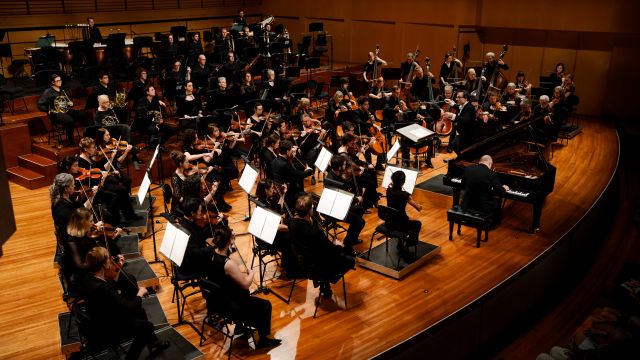Shostakovitich Ten
Two of the Russian greats were on display last night with Chief Conductor Umberto Clerici at the helm again, the concert including a performance of Prokofiev's third piano concerto with guest soloist Ukrainian born Australian Alexander Gavrylyuk at the piano along with a remarkable addition of a collage-like art movie entitled Oh To Believe in Another World designed by South African artist William Kentridge to accompany the main event, Shostakovich's Tenth Symphony.
Considered by many to be his greatest and interestingly composed after Stalin's death, Shostakovich had a somewhat troubled life living in Russia during the dictator's regime which sadly had a profound impact on his output as a composer including the performance of many of his works. However, it's endearing to know he survived numerous attempts to quell his talents whilst even incorporating bold 'musical-comments' as such in his compositions - subtle critiques, sometimes outrageous for their time. And who would blame him? It is this defiant spirit, alongside his ingenious talent, that makes his music so compelling.

Both works are very Russian in flavour, though unique in style to each composer, and therefore an evening of heavy, strident playing often coupled with extreme virtuosity. Sometimes we forget that many of the composers stemming from this era were remarkable musical all-rounders, often having renowned teachers from established training institutions and capable of composing, playing the piano, orchestrating and even conducting; and they were often more than damned proficient at all of these disciplines! I mean, look at Prokofiev's piano concerto on display at this concert: a work that requires highly efficient technical abilities being most acrobatic even to watch, let alone hear. Undoubtedly pouring out of a composer definitely out to impress as composer, orchestrator and pianist with its cascades of high-octane configurations zooming up and down the keyboard, along with a loud fast grinding orchestral musical accompaniment - perhaps more Prokofiev's style rather than that of the sound department - it is nevertheless a shame one couldn't always hear the piano part clearly. However, the work was brilliantly executed by Alexander Gavrylyuk and received such a rapturous reception from the audience an encore of a short piano solo (unannounced) was undoubtedly to ensue.
Shostakovich's tenth symphony, displaying marked maturity from such a versatile and prolific composer with a significant background both politically and emotionally, it's not surprising it was chosen by William Kentridge to add a visual interpretation but, as he imagined, in such a way as to accompany the symphony rather than the other way around. This works well, the film being very abstract in form, more in its setting whilst using major Russian figures of the Communist era as the centrepiece depicting the life in what appears to be an old faded museum. What is fascinating about the presentation is how the artist created the setting using predominantly cardboard, all pasted together on a large table, a micro-camera and puppets as such super-imposed but with photos of the main character's heads. It includes Lenin, Trotsky, Stalin, the poet Mayakovsky and even Shostakovich himself along with an array of archival footage. Very much a collage in presentation with regular comments punctuating the imagery in a silent-movie-like fashion relating to the life and sentiments of the time, this is a true art-form rarely seen these days and a decidedly intriguing addition to the concert. Rather than overshadowing the symphony, Kentridge’s work complemented it, offering a striking parallel narrative to Shostakovitch's deeply personal score, a lesson in history reimagined somewhat by a mischievous theatre troupe.

With devout passion and dexterity, profoundly presented by conductor, soloist and orchestra alike, adding to the festival atmosphere, arguably though illustrating a more alternative era of rich and challenging styles, one can experience how these composers were on another level, often writing in realms of intense progressive harmony and orchestration, a new-music as such, distinctively Russian in flavour and yet ably demonstrating versatility, often most theatrical and even melodic. It's always energising to encounter this style of progressive historic music again, to experience how brilliant it is, certainly in comparison to the simplicity of many ultra modern electronic styles we often encounter today. No doubt, this is one of the reasons why the audience were most appreciative at this performance demanding more than the usual amount of encores.
A concert of rare substance, this was a compelling blend of music, history, and visual art. Bold, intelligent, and moving, it was a great night out for anyone drawn to the richness of Russian music and the daring of artistic exploration.
Brian Adamson
Subscribe to our E-Newsletter, buy our latest print edition or find a Performing Arts book at Book Nook.

